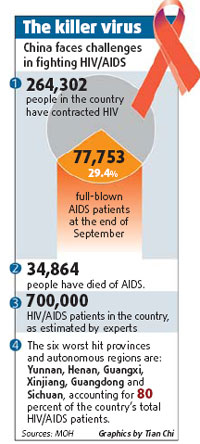The Ministry of Health (MOH) has begun a nationwide program to distribute new drugs among AIDS patients, a senior official said yesterday.
The second-line medicines - three anti-retroviral drugs - are being distributed free among full-blown AIDS patients, said Hao Yang, deputy director of the ministry's disease control bureau.
The second-line regimen includes two new drugs, TDF and Kaletra - as well as 3TC, which is also part of first-line drugs. All these medicines are imported and cost between 12,000 ($1,760) and 15,000 yuan a patient a year.
The cost of second-line drugs increases sharply from the first line's - 5 out of 7 of which are made in the country and cost between 5,000 and 8,000 yuan.
"The new drugs offer new hope to patients who have not responded well to the first-line treatment and developed drug resistance," Hao said.
The new free-drug campaign developed out of last year's clinical trial project in which 429 full-blown AIDS patients from Henan, Anhui and Hubei provinces were studied to test the efficacy of the "second-line" treatment.
 "The scheme has already yielded results," said Zhang Fujie, a researcher with the National Center for AIDS and Sexually Transmitted Disease Control and Prevention.
"The scheme has already yielded results," said Zhang Fujie, a researcher with the National Center for AIDS and Sexually Transmitted Disease Control and Prevention.
During the clinical trial, the virus among 70 percent of the patients declined rapidly after they took the second-line drugs for six months.
A rising number of people on first-line treatment are developing resistance to drugs and switching to second-line treatment, he said.
But the second-line treatment is not necessarily more effective than the first, Zhang said.
MOH figures show the government has provided free anti-retroviral treatment to 58,000 AIDS patients since 2003.
Thanks to the treatment, the mortality rate among AIDS patients dropped from 28.7 percent in 2002 to 5.8 percent in 2007, according to a survey of the National Center for AIDS and Sexually Transmitted Disease Control and Prevention. The study covered 37,305 patients receiving the treatment.
"The treatment is effective," Zhang said. "But its effect varies drastically among patients in different provinces."
Only nine of the more than 20 kinds of anti-AIDS drugs are available in the country, and whether a patient should get second-line treatment ought to be determined only through clinical test, Zhang said.
But clinical tests are still difficult to conduct in the country because indicators involve multiple factors and require special facilities and a lot of human resources, he said. "It's hard to conduct clinical tests also because many AIDS patients don't follow doctor's advice ... reducing their effect dramatically."
What is more worrying, he said, is that "once the second-line drugs become ineffective we'll be left with no solution".
(China Daily January 20, 2009)